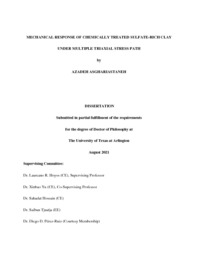
ATTENTION: The works hosted here are being migrated to a new repository that will consolidate resources, improve discoverability, and better show UTA's research impact on the global community. We will update authors as the migration progresses. Please see MavMatrix for more information.
Show simple item record
| dc.contributor.advisor | Hoyos, Laureano R. | |
| dc.contributor.advisor | Yu, Xinbao | |
| dc.creator | Asghariastaneh, Azadeh | |
| dc.date.accessioned | 2023-06-27T20:26:45Z | |
| dc.date.available | 2023-06-27T20:26:45Z | |
| dc.date.created | 2021-08 | |
| dc.date.issued | 2021-07-21 | |
| dc.date.submitted | August 2021 | |
| dc.identifier.uri | http://hdl.handle.net/10106/31332 | |
| dc.description.abstract | Expansive clayey soils, which are abundant in arid and semi-arid areas, including the state of Texas, can lead to excessive distress in pavements, foundations, embankments, earth retaining systems and other civil infrastructure that is either made of or supported by this type of soils. Calcium-based stabilizers, such as lime, cement and fly ash, have become popular soil stabilizers due to their ready availability and relatively low cost; however, myriad cases of failures of pavements and foundation built over sulfate-rich treated clay have led researchers to search for more efficient substitutes for calcium-based stabilizers. A very limited number of studies, however, have investigated the mechanical response of chemically treated clay under the wide range of multiple stress path that the soil is likely to undergo during the construction, postconstruction and/or soil excavation stages. In the present research work, a thorough assessment of the behavior of chemically treated expansive clay was accomplished by experimentally characterizing its mechanical response under multiple triaxial stress path, which can ultimately contribute to the postulation of more robust constitutive models for untreated and treated sulfate-rich expansive soils. A fully servo-controlled triaxial system was utilized to test natural and treated samples of highly plastic, sulfate-rich clay under unconsolidated-undrained hydrostatic compression (HC), proportional loading (PL), conventional triaxial compression (CTC), triaxial compression (TC) and triaxial extension (TE) stress path. Test results were used to experimentally calibrate key mechanical properties and constitutive parameters of natural and treated soils, including the assessment of critical state lines and compaction induced yield loci. The results showed that both 5% Type V cement + 15% Class F fly ash, and 6% lime + 4% Class F fly ash, can yield optimum performance in terms of volumetric stiffness, shear strength and critical state response of sulfate-rich expansive clay. However, in more practical terms, the mixture of 6% lime + 4% Class F fly ash would be most suitable as a treatment given the increased ductility that is manifestly observed from the stress-strain-stiffness response of lime-fly ash treated soil. | |
| dc.format.mimetype | application/pdf | |
| dc.language.iso | en_US | |
| dc.subject | Multiple stress path | |
| dc.subject | Expansive clay | |
| dc.title | MECHANICAL RESPONSE OF CHEMICALLY TREATED SULFATE-RICH CLAY UNDER MULTIPLE TRIAXIAL STRESS PATH | |
| dc.type | Thesis | |
| dc.date.updated | 2023-06-27T20:26:45Z | |
| thesis.degree.department | Civil Engineering | |
| thesis.degree.grantor | The University of Texas at Arlington | |
| thesis.degree.level | Doctoral | |
| thesis.degree.name | Doctor of Philosophy in Civil Engineering | |
| dc.type.material | text | |
| dc.creator.orcid | 0000-0002-6354-6743 | |
| local.embargo.terms | 2023-08-01 | |
| local.embargo.lift | 2023-08-01 | |
Files in this item
- Name:
- ASGHARIASTANEH-DISSERTATION-20 ...
- Size:
- 4.573Mb
- Format:
- PDF
This item appears in the following Collection(s)
Show simple item record


